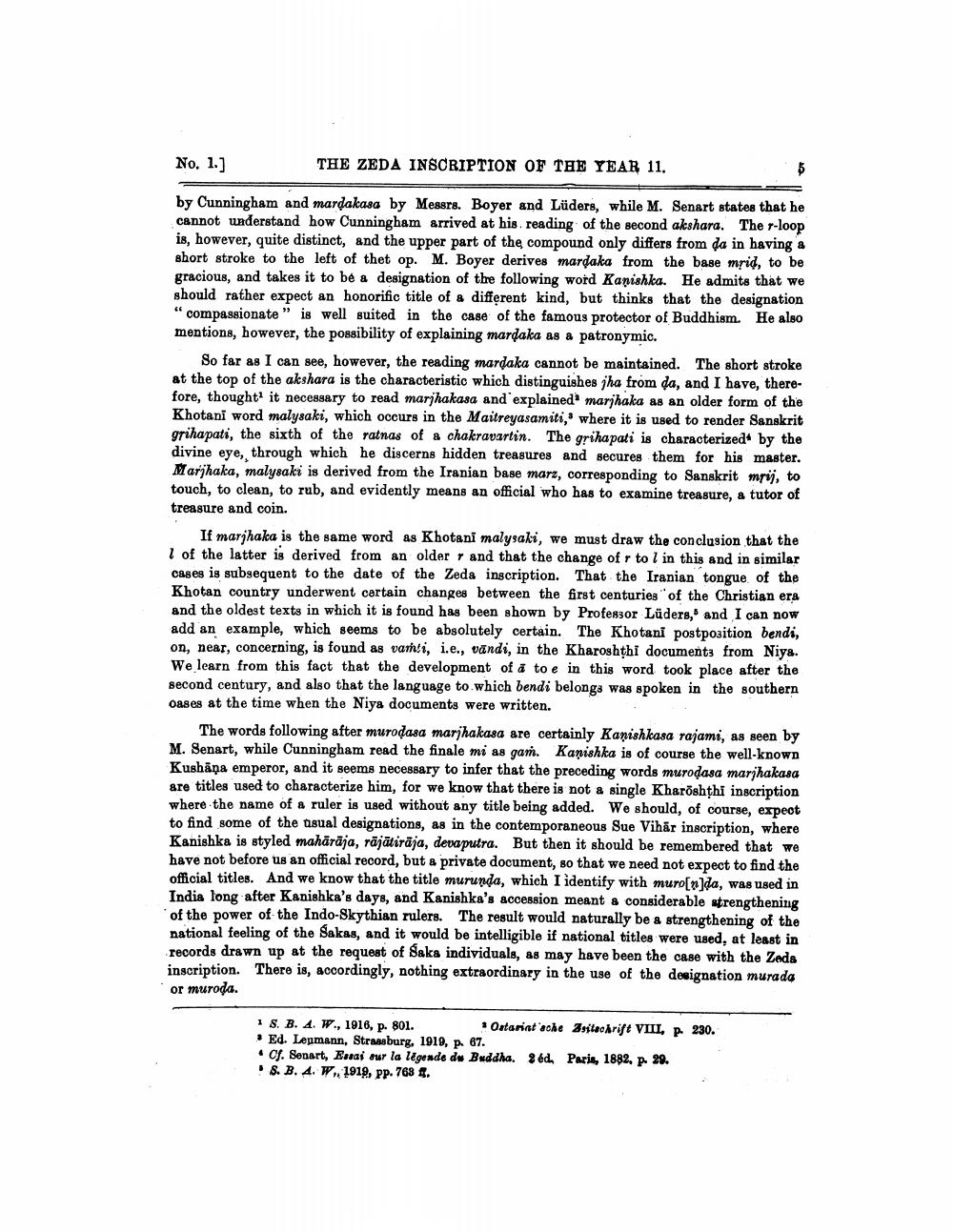________________
No. 1.]
THE ZEDA INSCRIPTION OF THE YEAR 11.
by Cunningham and mardakasa by Messrs. Boyer and Lüders, while M. Senart states that he cannot understand how Cunningham arrived at his reading of the second akshara. The r-loop is, however, quite distinct, and the upper part of the compound only differs from da in having a short stroke to the left of thet op. M. Boyer derives mardaka from the base mrid, to be gracious, and takes it to be a designation of the following word Kanishka. He admits that we should rather expect an honorific title of a different kind, but thinks that the designation compassionate" is well suited in the case of the famous protector of Buddhism. He also mentions, however, the possibility of explaining mardaka as a patronymic.
So far as I can see, however, the reading mardaka cannot be maintained. The short stroke at the top of the akshara is the characteristic which distinguishes jha from da, and I have, therefore, thought it necessary to read marjhakasa and explained marjhaka as an older form of the Khotani word malysaki, which occurs in the Maitreyasamiti, where it is used to render Sanskrit grihapati, the sixth of the ratnas of a chakravartin. The grihapati is characterized by the divine eye, through which he discerns hidden treasures and secures them for his master. Marjhaka, malysaki is derived from the Iranian base marz, corresponding to Sanskrit mrij, to touch, to clean, to rub, and evidently means an official who has to examine treasure, a tutor of treasure and coin.
If marjhaka is the same word as Khotani malysaki, we must draw the conclusion that the I of the latter is derived from an older r and that the change of r to l in this and in similar cases is subsequent to the date of the Zeda inscription. That the Iranian tongue of the Khotan country underwent certain changes between the first centuries of the Christian era and the oldest texts in which it is found has been shown by Professor Lüders, and I can now add an example, which seems to be absolutely certain. The Khotani postposition bendi, on, near, concerning, is found as vamti, i.e., vandi, in the Kharoshthi documents from Niya. We learn from this fact that the development of a to e in this word took place after the second century, and also that the language to which bendi belongs was spoken in the southern oases at the time when the Niya documents were written.
The words following after murodasa marjhakasa are certainly Kanishkasa rajami, as seen by M. Senart, while Cunningham read the finale mi as gam. Kanishka is of course the well-known Kushana emperor, and it seems necessary to infer that the preceding words muroḍasa marjhakasa are titles used to characterize him, for we know that there is not a single Kharōshthi inscription where the name of a ruler is used without any title being added. We should, of course, expect to find some of the usual designations, as in the contemporaneous Sue Vihar inscription, where Kanishka is styled mahārāja, rājātiräja, devaputra. But then it should be remembered that we have not before us an official record, but a private document, so that we need not expect to find the official titles. And we know that the title murunda, which I identify with muro[n]da, was used in India long after Kanishka's days, and Kanishka's accession meant a considerable strengthening of the power of the Indo-Skythian rulers. The result would naturally be a strengthening of the national feeling of the Sakas, and it would be intelligible if national titles were used, at least in records drawn up at the request of Saka individuals, as may have been the case with the Zeda inscription. There is, accordingly, nothing extraordinary in the use of the designation murada or muroda.
1 S. B. 4. W., 1916, p. 801.
Ed. Leumann, Strassburg, 1919, p. 67.
Ostariat'sche Zeitschrift VIII, p. 230.
Cf. Senart, Essai sur la légende du Buddha. 2éd, Paris, 1882, p. 29. S. B. 4. W 1919, pp. 763 .




